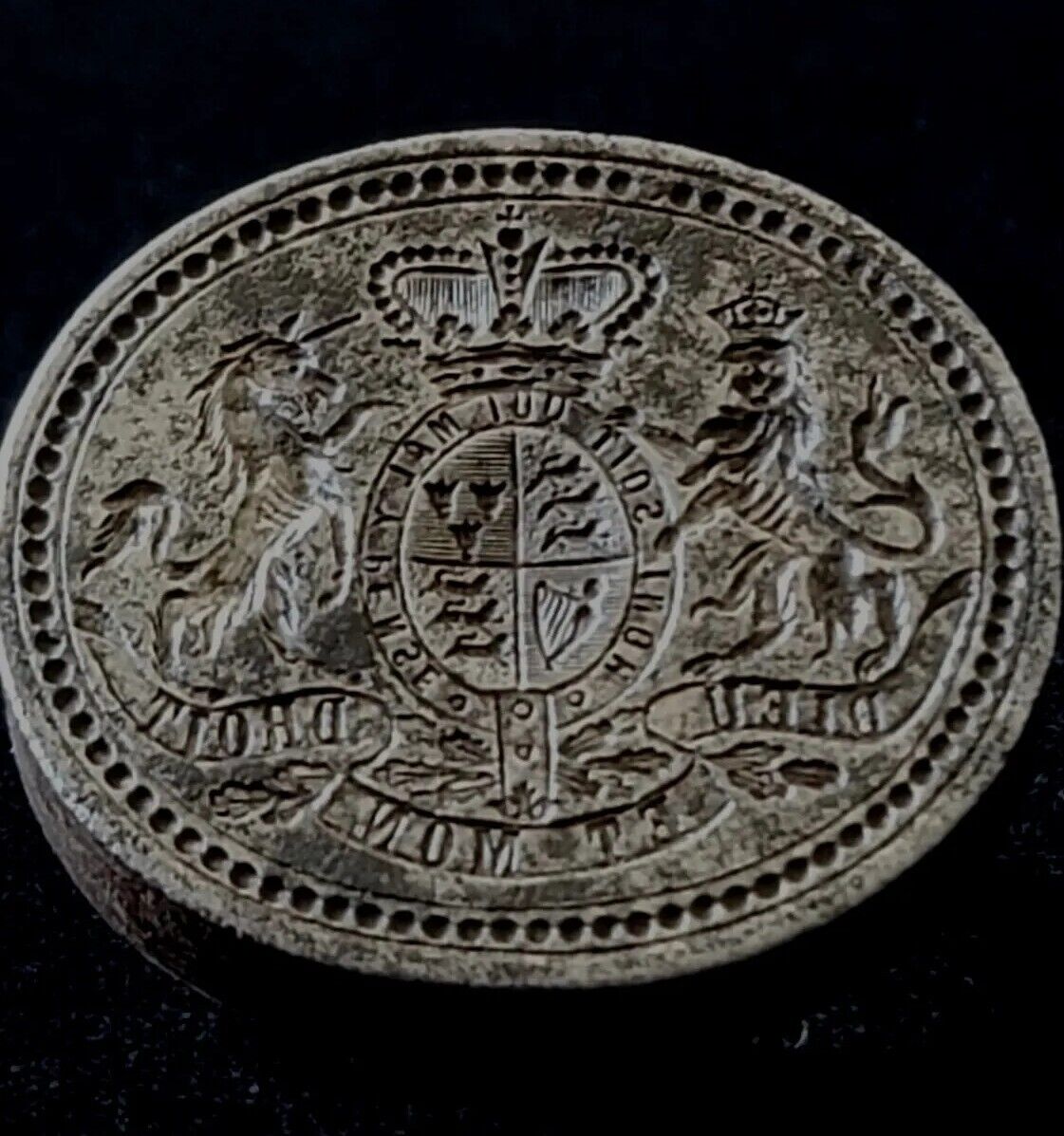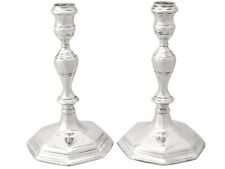Queen Anne Royal Wax Document Seal Desk Stamp British Coat Arms Royalty Crown UK

When you click on links to various merchants on this site and make a purchase, this can result in this site earning a commission. Affiliate programs and affiliations include, but are not limited to, the eBay Partner Network.
Queen Anne Royal Wax Document Seal Desk Stamp British Coat Arms Royalty Crown UK:
$9399.96
LOT-GB130. For your consideration is an exceedingly rare and historically important original antique c.1707 royal desk wax document privy seal of H.M. Queen Anne of Great Britain and Ireland. Royal cipher matrix used to sign and seal official royal State documents. Missing original wood handle, as pictured. Although missing, words can not adequately describe the rarity and significance of this seal stamp.
British royal wax desk seal stamp is masterfully hand-engraved with the personal royal cipher and British coat of arms for Queen Anne, featuring a Queen's crown.
The coat of arms of Queen Anne featuring a rampant lion and unicorn. The image bears the old French motto "Honi soit qui mal y pense" (Shame be to him who thinks evil of it) and the Latin motto "Semper eadem" (Always the same).
Royal wax seal stamp is constructed entirely from solid steel. Diameter of oval royal steel matrix is approximately 1.625". Height is approximately 1.0". Weight is 87.88 grams. Condition is original. The royal seal matrix is original. Provenance: private collector. Museum quality. One of a kind. Guaranteed authentic.
Anne (6 February 1665 – 1 August 1714) was Queen of Great Britain and Ireland following the ratification of the Acts of Union on 1 May 1707, which merged the kingdoms of Scotland and England. Prior to this, she was Queen of England, Scotland, and Ireland from 8 March 1702.
Anne was born during the reign of her uncle King Charles II. Her father was Charles's younger brother and heir presumptive, James, whose suspected Roman Catholicism was unpopular in England. On Charles's instructions, Anne and her elder sister Mary were raised as Anglicans. Mary married their Dutch Protestant cousin, William III of Orange, in 1677, and Anne married the Lutheran Prince George of Denmark in 1683. On Charles's death in 1685, James succeeded to the throne, but just three years later, he was deposed in the Glorious Revolution of 1688. Mary and William became joint monarchs. Although the sisters had been close, disagreements over Anne's finances, status, and choice of acquaintances arose shortly after Mary's accession, and they became estranged. William and Mary had no children. After Mary's death in 1694, William reigned alone until his own death in 1702, when Anne succeeded him.
During her reign, Anne favored moderate Tory politicians, who were more likely to share her Anglican religious views than their opponents, the Whigs. The Whigs grew more powerful during the course of the War of the Spanish Succession until 1710 when Anne dismissed many of them from office. Her close friendship with Sarah Churchill, Duchess of Marlborough, turned sour as the result of political differences. The Duchess took revenge with an unflattering description of the Queen in her memoirs, which was widely accepted by historians until Anne was reassessed in the late 20th century.
Anne was plagued by poor health throughout her life, and from her thirties, she grew increasingly ill and obese. Despite 17 pregnancies, she died without surviving issue and was the last monarch of the House of Stuart. Under the Act of Settlement 1701, which excluded all Catholics, she was succeeded by her second cousin George I of the House of Hanover.
Anne became queen upon the death of King William III on 8 March 1702, and was immediately popular. In her first speech to the English Parliament, on 11 March, she distanced herself from her late Dutch brother-in-law and said, "As I know my heart to be entirely English, I can very sincerely assure you there is not anything you can expect or desire from me which I shall not be ready to do for the happiness and prosperity of England."
Soon after her accession, Anne appointed her husband Lord High Admiral, giving him nominal control of the Royal Navy. Anne gave control of the army to Lord Marlborough, whom she appointed Captain-General. Marlborough also received numerous honours from the Queen; he was created a Knight of the Garter and was elevated to the rank of duke. The Duchess of Marlborough was appointed Groom of the Stool, Mistress of the Robes, and Keeper of the Privy Purse.
Anne was crowned on St George's Day, 23 April 1702. Affected by gout, she was carried to Westminster Abbey in an open sedan chair, with a low back to permit her train to flow out behind her. On 4 May, England became embroiled in the War of the Spanish Succession, in which England, Austria, and the Dutch Republic fought against France and Bourbon Spain. Charles II of Spain had died childless in 1700, and the succession was disputed by two claimants: the Habsburg Archduke Charles of Austria and the Bourbon Philip, Duke of Anjou.
She took a lively interest in affairs of state, and was a patron of theatre, poetry and music. She subsidised George Frideric Handel with £200 a year. She sponsored high-quality medals as rewards for political or military achievements. They were produced at the Mint by Isaac Newton and John Croker. She knighted Newton when she visited Cambridge in 1705.
While Ireland was subordinate to the English Crown and Wales formed part of the kingdom of England, Scotland remained an independent sovereign state with its own parliament and laws. The Act of Settlement 1701, passed by the English Parliament, applied in the kingdoms of England and Ireland but not Scotland, where a strong minority wished to preserve the Stuart dynasty and its right of inheritance to the throne. Anne had declared it "very necessary" to conclude a union of England and Scotland in her first speech to the English Parliament, and a joint Anglo-Scots commission met at her former residence, the Cockpit, to discuss terms in October 1702. The negotiations broke up in early February 1703 having failed to reach an agreement. The Estates of Scotland responded to the Act of Settlement by passing the Act of Security, which gave the Estates the power, if the Queen had no further children, to choose the next Scottish monarch from among the Protestant descendants of the royal line of Scotland. The individual chosen by the Estates could not be the same person who came to the English throne, unless England granted full freedom of trade to Scottish merchants. At first, Anne withheld royal assent to the act, but she granted it the following year when the Estates threatened to withhold supply, endangering Scottish support for England's wars.
Queen Anne Royal Wax Document Seal Desk Stamp British Coat Arms Royalty Crown UK:
$9399.96

Related Items:
Antique Queen Anne Britannia Standard Silver Candlesticks 672g Height 17.7cm
$16840.00
Isaac Brokaw New Jersey Brass Dial Queen Anne Walnut Tall Case Grandfather Clock
$14500.00
Britannia Standard Silver Quart and a Half Tankard - Antique Queen Anne
$13898.51







